Kenneth C. Davis's Blog, page 35
October 5, 2020
Who Said It? (10/5)
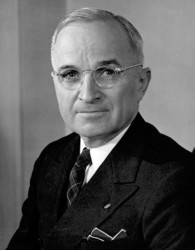
President Harry S. Truman
(Photo: Truman Library)
President Harry S. Truman in the first-ever televised address from the White House (October 5, 1947).
As post-war Europe struggled to recover, Truman asked Americans to refrain from eating meat and eggs on different days to help stockpile food supplies. The effort was mostly symbolic and was a prelude to the far more ambitious Marshall Plan which had a much greater impact on post-World War II Europe.
The food-saving program which has just been presented to you has my wholehearted support. I am confident that it will have the support of every American.
The situation in Europe is grim and forbidding as winter approaches. Despite the vigorous efforts of the European people, their crops have suffered so badly from droughts, floods, and cold that the tragedy of hunger is a stark reality.
The nations of Western Europe will soon be scraping the bottom of the food barrel. They cannot get through the coming winter and spring without help–generous help-from the United States and from other countries which have food to spare.
I know every American feels in his heart that we must help to prevent starvation and distress among our fellow men in other countries…
It is simple and straightforward. It can be understood by all. Learn it–memorize it–keep it always in mind. Here it is: One: Use no meat on Tuesdays.
Two: Use no poultry or eggs on Thursdays.
Three: Save a slice of bread every day.
Four: Public eating places will serve bread and butter only on request.
Complete Text and Source: “Radio and Television Address Concluding a Program by the Citizens Food Committee,” October 5, 1947. Online by Gerhard Peters and John T. Woolley, The American Presidency Project.
Read more about Truman and the post war world in Don’t Know Much About the American Presidents, Don’t Know Much About History and The Hidden History of America At War.
September 26, 2020
A Parade More Deadly Than War
[Update of 11/2018 post]
In late September 1918, Philadelphia put on a parade to sell war bonds in the midst of the outbreak of what was commmonly called Spanish flu. It was a catastrophe. I recounted this event in an article for Smithsonian.
As we live through the most deadly pandemic since 1918, it is more important than ever to understand the lessons of history. Specifically, from 1918 we should have learned these simple lessons:
•Lies, propaganda and censorship can kill
•Ignoring science is lethal
•Misplaced priorities are More Deadly Than War
Read this story of Philadelphia and the flu.
It was a parade like none Philadelphia had ever seen.
In the summer of 1918, as the Great War raged and American doughboys fell on Europe’s killing fields, the City of Brotherly Love organized a grand spectacle. To bolster morale and support the war effort, a procession for the ages brought together marching bands, Boy Scouts, women’s auxiliaries, and uniformed troops to promote Liberty Loans –government bonds issued to pay for the war. The day would be capped off with a concert led by the “March King” himself –John Philip Sousa.
The city sought to sell Liberty Loans, bonds to pay for the war effort, while bringing its citizens together during the infamous pandemic.
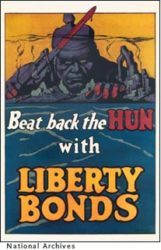
Read the complete article: “Philadelphia Threw a WWI Parade That Gave Thousands of Onlookers the Flu” from Smithsonian Magazine
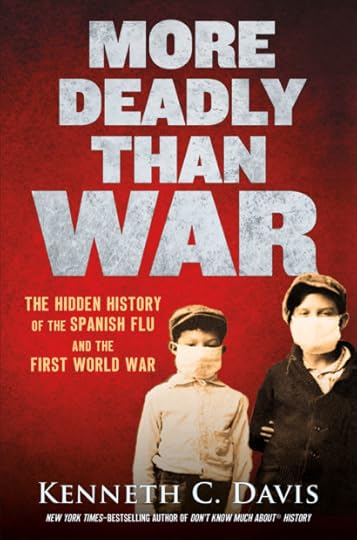
September 15, 2020
STRONGMAN: The Rise of Five Dictators and the Fall of Democracy
First pre-publication review is in. It is a Starred review from Kirkus Reviews
“History’s warnings reverberate in this gripping read about five dictatorial strongmen. This complex yet accessible title examines the lives and deeds of Benito Mussolini, Adolf Hitler, Joseph Stalin, Mao Zedong, and Saddam Hussein….
A pitch-perfect balance of nuanced reflection and dire warning.”
On October 6, 2020, my new book, STRONGMAN: The Rise of Five Dictators and the Fall of Democracy, will be published Preorder the hardcover and e-book from Holt Books. An audiobook edition will be released by Penguin Random House at the same time.
In it, I recount the story of the rise to power of five of the most deadly dictators of the 20th century — Mussolini, Hitler, Stalin, Mao Zedong, and Saddam Hussein.
In addition to telling how these men took unlimited power, brought one-party rule to their nations, and were responsible for the deaths of millions of people, the book offers a brief history of Democracy and discusses the present threat to democratic institutions around the world.
A review in Booklist says, “Davis does not sugarcoat his material, inviting long thoughts with his assertion that this is a decidedly human story that points to real people as evidence that evil exists in this troubled world.”
In a time when Democracy is under assault across the globe, it is more important than ever to understand how a Strongman takes power and how quickly democracy can vanish –even as millions cheer its death.
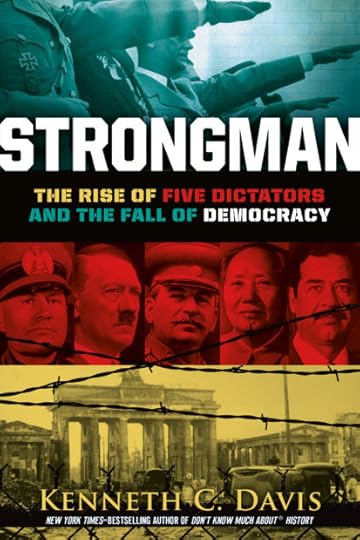 ADVANCE PRAISE FOR STRONGMAN
ADVANCE PRAISE FOR STRONGMAN
“I found myself engrossed in it from beginning to end. I could not help admiring Davis’s ability to explain complex ideas in readable prose that never once discounted the intelligence of young readers. It is very much a book for our time.”
—Sam Wineburg, Margaret Jacks Professor of Education & History, Stanford University, author of Why Learn History (When It’s Already on Your Phone).
“Strongman is a book that is both deeply researched and deeply felt, both an alarming warning and a galvanizing call to action, both daunting and necessary to read and discuss.”
—Cynthia Levinson, author of Fault Lines in the Constitution: The Framers, Their Fights, and the Flaws That Affect Us Today
“A wake-up call to democracies like ours: we are not immune to despots . . . Strongman demonstrates that democracy is not permanent, unless it is collectively upheld. This book shakes that immortality narrative.”
—Jessica Ellison, President of the Minnesota Council for the Social Studies; Teacher Education Specialist, Minnesota Historical Society
Rarely does a history book take such an unflinching look at our common future, where the very presence of democracy is less than certain; even rarer is a history book in which the author’s moral convictions incite young readers to civic engagement; rarest of all, a history book as urgent, as impassioned, and as timely as Kenneth C. Davis’ Strongman.
—Eugene Yelchin, author of the Newbery Honor book Breaking Stalin’s Nose.
NEWS of STRONGMAN – This book has been made a selection of the Junior Library Guild.
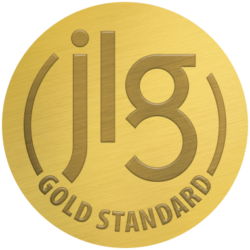
Watch for more news about STRONGMAN here in the coming months.
September 2, 2020
The Month That Changed The World: 1945, 75 Years Ago

Formal surrender aboard USS Missouri Sept. 2. 1945 https://www.history.navy.mil/our-coll...
Today is “V-J Day,” on this date September 2, 1945, the Japanese formally surrendered aboard the USS Missouri, ending World War II.
From “Trinity” to V-J Day
The Month That Changed the World

The Atomic Bomb Dome-Hiroshima (Photo Courtesy of Hiroshima and Nagasaki Remembered)
On August 6, 1945, the New York Times asked:
“What is this terrible new weapon?”
(New York Times, August 6, 1945: “First Atomic Bomb Dropped on Japan”)
The story followed the announcement made by President Harry S. Truman:
“SIXTEEN HOURS AGO an American airplane dropped one bomb on Hiroshima, an important Japanese Army base. That bomb had more power than 20,000 tons of T.N.T. It had more than two thousand times the blast power of the British ‘Grand Slam’ which is the largest bomb ever yet used in the history of warfare.”
August 6, 1945
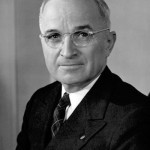
President Harry S. Truman
(Photo: Truman Library)
(“Statement by the President Announcing the Use of the A-Bomb at Hiroshima”: Truman Library and Museum)
ON July 16, 1945, the first atomic device, nicknamed “the Gadget,” was detonated in the “Trinity” test at Alamogordo, New Mexico. Read this excellent account of the test in National Geographic.
In the course of the next weeks, the world would be transformed, with the arrival of the Atomic Age, Japan’s surrender, the end of World War II, the charter of the United Nations, and the beginning of the Cold War.
The following timeline summarizes the extraordinary series of events that helped make the modern world between July 16 and August 15, 1945.
July 17 In Potsdam, near Berlin in defeated Germany, Harry S. Truman came face to face with the Soviet dictator Joseph Stalin. Truman had taken office upon the death of President Roosevelt on April 12 without knowledge of the Manhattan Project or the atomic bomb’s existence. After being told about the potential weapon, Truman was informed of the successful “Trinity” test while meeting Stalin with British Prime Minister Winston Churchill at the European postwar conference.
“I told Stalin that I am no diplomat but usually said yes or no to questions after hearing all the argument.”
Following the successful test in New Mexico, the components of the atomic bomb were loaded on the USS Indianapolis and transported to an airbase on Tinian Island in the Pacific. Many of the crew of nearly 1,200 men had no idea what the ship was carrying.
Jul7 24 Truman informed Stalin of a “new weapon of unusual destructive force.” But Stalin already know about the atomic bomb because of a network of spies inside the Manhattan Project.

The Hidden History of America At War (paperback)
The race to capture Berlin in April and May 1945 by the Soviet Red Army was motivated in part by Stalin wanting to secure German scientists working on the atomic bomb and tons of uranium held in a Berlin lab. This episode is recounted in the “Berlin Stories” chapter of my book The Hidden History of America at War.
July 26: Prime Minister Winston Churchill was defeated in the general election and replaced by Clement Attlee as Prime Minister.
“The landslide victory comes as a major shock to the Conservatives following Mr Churchill’s hugely successful term as Britain’s war-time coalition leader, during which he mobilised and inspired courage in an entire nation.”
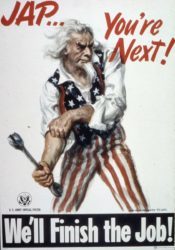
U.S. Propaganda poster (Source National Archives https://catalog.archives.gov/id/513563)
–BBC
At the Potsdam Conference, the Potsdam Declaration demanded “Unconditional surrender” by Japan. Issued by Great Britain, China, and the U.S., it threatened:
“The alternative for Japan is prompt and utter destruction.”
The Indianapolis reached Tinian that day.

USS Indianapolis 10 July 1945, after final overhaul and repair of combat damage. Photograph from the Bureau of Ships Collection in the U.S. National Archives (Naval History and Heritage Command https://usnhistory.navylive.dodlive.m...)
“Indianapolis departed San Francisco on 16 July 1945, foregoing her post-repair shakedown period. Touching at Pearl Harbor on 19 July, she raced on unescorted and reached Tinian on 26 July, covering some 5,000 miles from San Francisco in only ten days.”
After delivering the atomic bomb components, the ship sailed for Guam and the Philippines. On July 30, the ship was torpedoed by a Japanese submarine and sank in twelve minutes.
“What followed was an ordeal of hell on earth for those who survived the sinking. For a whole host of reasons, many related to the secrecy of her atom bomb mission, the rest of the Navy did not know that Indianapolis was missing.”
— Sam Cox (Rear Adm., USN, Ret.), “Lest We Forget: USS Indianapolis and her sailors”
July 29 The Japanese government rejected the surrender demand.
July 31 The assembly of the atomic bomb, code named “Little Boy,” was completed. The final arming of the bomb would be done in-flight.

In Potsdam, Truman was notified of the bomb being ready. He wrote a message that concluded:
“Release when ready, but not sooner than August 2. HST”
According to the Truman Library:

The actual reply that President Truman wrote on July 31, 1945 (Photo taken by Dawn Wilson at the Harry S. Truman Presidential Library)
“No known written record exists in which Harry Truman explicitly ordered the use of atomic weapons against Japan. The closest thing to such a document is this handwritten order, addressed to Secretary of War Henry Stimson, in which Truman authorized the release of a public statement about the use of the bomb. It was written on July 31, 1945 while Truman was attending the Potsdam Conference in Germany. In effect, this served as final authorization for the employment of the atomic bomb, though the expression ‘release when ready’ refers to the public statement.”
August 1 The atomic bomb was ready and flight orders were prepared. But weather delayed the mission. Of four potential target cities, Hiroshima was chosen as the primary target.
In Potsdam that day, the Big Three were wrapping up their meetings and discussed plans for the trials of war criminals that later become known as the Nuremberg Trials.
In the Pacific, hundreds of survivors from the Indianapolis were desperately trying to stay afloat in the shark-infested waters.
“In that clear water you could see the sharks circling. Then every now and then, like lightning, one would come straight up and take a sailor and take him straight down.” – Survivor of the Indianapolis sinking to the BBC.
August 2 The U.S. Navy was still unaware that the Indianapolis had gone down. About 800 men had gone into the water and the survivors were spotted by a reconnaissance plane four days after the sinking; 317 survivors were rescued.

The Big Three at the end of the Potsdam Conference: Front row (Left to Right) Prime Minister Attlee, President Truman, Generalissimo Stalin. Source: Army Signal Corps Collection in the U.S. National Archives.
Shortly after midnight on August 2, the Potsdam Conference concluded with a joint communique. It included reference to the United Nations, whose organization and charter had been completed on June 26 at a conference in San Francisco.
Truman spoke of a future Washington meeting, but he and Stalin never met again.
What was clear was that the Conference had solidified the Soviet Union’s domination over much of Eastern Europe, including the eastern half of a divided Germany. Admiral William D. Leahy, Truman’s Chief of Staff, later wrote:
“The Soviet Union emerged at this time as the unquestioned all-powerful influence in Europe….”
August 4 Colonel Paul Tibbets briefed the men of the 509th Composite Group -the weapon delivery arm of the Manhattan Project. Tibbets was the commander of the unit. His men do not know the nature of the bomb they will carry.
August 5 The bombing mission was confirmed and Colonel Paul Tibbets announced he would pilot the plane which he named “Enola Gay,” after his mother.

Colonel Paul W. Tibbets, Jr., Pilot of the Enola Gay, the Plane that Dropped the Atomic Bomb August 6, 1945 (National Archives https://catalog.archives.gov/id/535737)
August 6 8:15 AM local time: The first atomic bomb was detonated over Hiroshima.
“In less than one second, the fireball had expanded to 900 feet. The blast wave shattered windows for a distance of ten miles and was felt as far away as 37 miles. Over two-thirds of Hiroshima’s buildings were demolished. The hundreds of fires, ignited by the thermal pulse, combined to produce a firestorm that had incinerated everything within about 4.4 miles of ground zero.”
Source: Hiroshima and Nagasaki Remembered.
“In the street, the first thing he saw was a squad of soldiers who had been burrowing into the hillside opposite, making one of the thousands of dugouts in which the Japanese apparently intended to resist invasion, hill by hill, life for life; the soldiers were coming out of the hole, where they should have been safe, and blood was running from their heads, chests, and backs. They were silent and dazed.
Under what seemed to be a local dust cloud, the day grew darker and darker.”
–John Hersey, “Hiroshima,” New Yorker (August 24, 1946)
In Hiroshima, the estimated death toll was eighty thousand people killed instantly; as many as 90 percent of the city’s nurses and doctors also died instantly. By 1950, as many as 200,000 had died as a result of long-term effects of radiation.
In his official announcement, President Truman said,
It was to spare the Japanese people from utter destruction that the ultimatum of July 26 was issued at Potsdam. Their leaders promptly rejected that ultimatum. If they do not now accept our terms they may expect a rain of ruin from the air, the like of which has never been seen on this earth. Behind this air attack will follow sea and land forces in such numbers and power as they have not yet seen and with the fighting skill of which they are already well aware.
Read Don’t Know Much About Hiroshima for more details about the bombing and its aftermath.
August 7 On Guam, the decision to use a second device was made and the mission date set for August 10, then moved to August 9 over weather concerns.
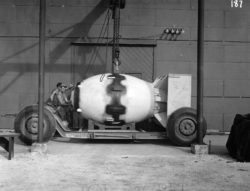
Fat Man being lowered and checked on transport dolly for airfield trip Image Source: Heritage Foundation https://www.atomicheritage.org/histor...
August 8 Fulfilling a pledge Stalin made earlier at the Yalta conference, the Soviet Union declared war on Japan and invaded Manchuria the next day, sending more than one million troops into Japanese-held territory.
The Japanese military leadership was still divided over the surrender demand, with some leading generals vowing to fight to the death. A coup against Emperor Hirohito began to be planned by members of the Japanese military.
A plutonium bomb code named “Fat Man” is prepared on Tinian. It will be carried by a B-29 called “Bockscar.” The primary target was the city of Kokura, home to a large munitions plant.
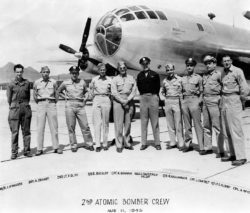
The crew of the B-29 called “Bockscar” taken after the Nagasaki bombing (Image: U.S. Air Force)
August 9 When clouds and smoke from nearby fires obscured Kokura, “Fat Man” was instead dropped over the secondary target, the city of Nagasaki, with a population estimated at 263,000, a city that was home to two Mitsubishi military plants. It is also the site of a prisoner of war camp.
“Nagasaki was a city on the west coast of Kyushu on picturesque Nagasaki Bay. It was famous as the setting for Puccini’s beautiful opera Madame Butterfly. It was also home to two huge Mitsubishi war plants on the Urakami River. This complex was the primary target, but because the city was built in hilly, almost mountainous terrain, it was a much more difficult target than Hiroshima…
Fat Man exploded at 1,840 feet above Nagasaki and approximately 500 feet south of the Mitsubishi Steel and Armament Works with an estimated force of 22,000 tons of TNT.
Unlike Hiroshima, there was no firestorm at Nagasaki. Despite this, the blast was more destructive to the immediate area, due to the topography and the greater power of Fat Man.”
The death toll in Nagasaki also reached 80,000 by the end of 1945. Read a full account of this mission in “Nagasaki: The Last Bomb” by Alex Wellerstein (New Yorker, August 7, 2015)
The National Archives “Unwritten Record” blog also offers resources on the atomic bombings.
August 10 After Nagasaki was bombed, Truman ordered no more strikes without his authorization. Another plutonium core for a third weapon was prepared for shipment.
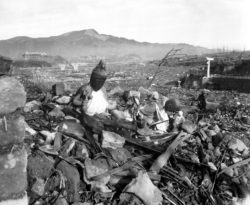
September 24, 1945, 6 weeks after Nagasaki was destroyed by the world’s second atomic bomb attack. Photo by Cpl. Lynn P. Walker, Jr. (USMC) National Archives FILE #: 127-N-136176
Although an unofficial surrender message was sent by a Japanese news agency, the Japanese cabinet was divided and no decision was made. The Emperor would not surrender his sovereignty.
August 11 The U.S. Secretary of State James Byrnes rejected any conditional surrender and stated that the Emperor and Japan’s government will be subject to the Allied Powers and declared that any future Japanese government must reflect the will of the people.
Soviet troops invade South Sakhalin island, Japanese-held territory.
August 12-13 Soviet troops advanced into the Korean peninsula.
Emperor Hirohito agreed to accept the terms of Secretary Byrnes’ note and ordered the suspension of military activity. He recorded a surrender announcement. Military officers began to plot against Hirohito in a coup known as the “Kyujo incident.”
August 13 The bombing of Japan, including firebombing, resumed with more than 1,000 B-29s taking part.
Japanese officers continued to seek allies in their planned coup against the Imperial government.
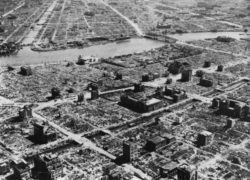
Residential section of Tokyo after the March 1945 air raids. (Wikimedia commons http://www.kmine.sakura.ne.jp/kusyu/k...
August 14 (August 15 in Japan): The military coup failed and several plotters committed suicide.
In an extraordinary address recorded earlier, the Emperor of Japan spoke on the radio for the first time and accepted the provisions of the Potsdam Declaration, agreeing to the unconditional surrender.
Read: “The Emperor’s Speech” by Max Fisher (The Atlantic, August 15, 2012)
At a White House conference, according to United Press International, Truman said:
“This is the day when Fascist and police governments cease to exist in the world. This is the day for democracy.”
-Source: “Japan Surrenders Unconditionally, World At Peace” UPI archives
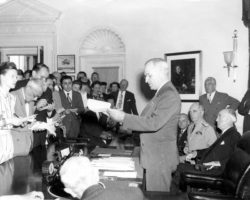
Truman announces Japan’s surrender to reporters in Oval Office.
Credit: Rowe, Abbie National Park Service Harry S. Truman Library & Museum.
Across America and England, jubilant crowds filled the streets once more for an unofficial V-J (Victory over Japan) Day, as they had three months earlier on VE Day, May 8,1945, after Germany’s surrender ended the war in Europe.
A video clip of Truman’s August 14 announcement from C-Span.

V-J Day Times Square August 14, 1945 Library of Congress Prints and Photographs Division. New York World-Telegram and the Sun Newspaper Photograph Collection. http://hdl.loc.gov/loc.pnp/cph.3c19650
September 2, 1945 A formal surrender ceremony was performed in Tokyo Bay and that date is also referred to as V-J Day.
Almost since the day the first atomic bomb was dropped on Hiroshima, critics have second-guessed Truman’s decision and motives. A generation of historians and commentators have defended or repudiated the need for unleashing the atomic weapon. Admiral William D. Leahy, who was with Truman at Potsdam, later wrote in a memoir:
Once it had been tested, President Truman faced the decision as to whether to use it. He did not like the idea, but he was persuaded that it would shorten the war against Japan and save American lives. It is my opinion that the use of this barbarous weapon at Hiroshima and Nagasaki was of no material assistance in our war against Japan.
–William D. Leahy, I Was There (1950)
In China, however, the Japanese surrender ended the wartime alliance between the Communists and Nationalists. The Chinese civil war began anew, with the US supporting Chiang Kai-shek’s Nationalists and Stalin’s USSR backing Mao Zedong’s Communists.
Many historians contend that preventing death and casualties in an invasion of Japan was only a partial explanation for the use of the two atomic bombs. The United States was already wary of Stalin and his designs on Japan’s wartime territory. They argue that the use of the two devices was meant to end the war quickly to prevent Stalin from capturing territory held by Japan. It may have also been a signal to Stalin and the Soviet Union that the United States possessed these weapons and was willing to use them.
In other words, the dropping of the atomic bombs became the first volley in the Cold War.
READ about the debate in this Smithsonian article.
In 1952, Albert Einstein –whose 1939 letter to Franklin D. Roosevelt had set the Manhattan Project in motion — wrote a brief essay published by a Japanese magazine Kaizo in which he stated:
I was well aware of the dreadful danger for all mankind, if these experiments would succeed. But the probability that the Germans might work on that very problem with good chance of success prompted me to take that step. I did not see any other way out, although I always was a convinced pacifist. To kill in war time, it seems to me, is in no ways better than common murder.
He concluded:
Gandhi, the greatest political genius of our time has shown the way, and has demonstrated the sacrifices man is willing to bring if only he has found the right way. His work for the liberation of India is a living example that man’s will, sustained by an indomitable conviction is stronger than apparently invincible material power.
–Source Hiroshima & Nagasaki Remembered
You can read more about Hiroshima and the dropping of the atomic bombs in Don’t Know Much About History and more about President Truman in Don’t Know Much About the American Presidents and in The Hidden History of America At War. Read more about Mussolini, Hitler, and Stalin in STRONGMAN which will be published on October 6, 2020.
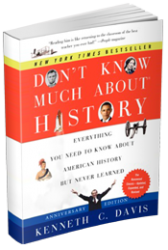


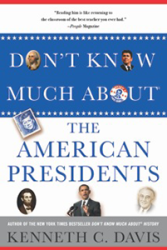
August 30, 2020
Who Said It? (Labor Day edition)
(Reposted from 2014)
Capital is only the fruit of labor, and could never have existed if labor had not first existed. Labor is the superior of capital, and deserves much the higher consideration.

Abraham Lincoln (November 1863) Photo by Alexander Gardner
Abraham Lincoln, “First Annual Message to Congress” (“State of the Union”) December 3, 1861
It is not needed nor fitting here that a general argument should be made in favor of popular institutions, but there is one point, with its connections, not so hackneyed as most others, to which I ask a brief attention. It is the effort to place capital on an equal footing with, if not above, labor in the structure of government. It is assumed that labor is available only in connection with capital; that nobody labors unless somebody else, owning capital, somehow by the use of it induces him to labor. This assumed, it is next considered whether it is best that capital shall hire laborers, and thus induce them to work by their own consent, or buy them and drive them to it without their consent. Having proceeded so far, it is naturally concluded that all laborers are either hired laborers or what we call slaves. And further, it is assumed that whoever is once a hired laborer is fixed in that condition for life.
Now there is no such relation between capital and labor as assumed, nor is there any such thing as a free man being fixed for life in the condition of a hired laborer. Both these assumptions are false, and all inferences from them are groundless.
Labor is prior to and independent of capital. Capital is only the fruit of labor, and could never have existed if labor had not first existed. Labor is the superior of capital, and deserves much the higher consideration. Capital has its rights, which are as worthy of protection as any other rights.
Source and Complete text: Abraham Lincoln: “First Annual Message,” Read more about Lincoln, his life and administration and the Civil War in Don’t Know Much About® History, Don’t Know Much About® the Civil War and Don’t Know Much About® the American Presidents
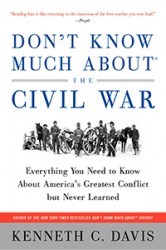
Don’t Know Much About the Civil War (Harper paperback, Random House Audio)
[image error]
Don’t Know Much About® History: Anniversary Edition (Harper Perennial and Random House Audio)
[image error]
Don’t Know Much About® the American Presidents (Hyperion Paperback-April 15, 2014)
August 28, 2020
Labor Day
“Labor is the superior of capital and deserves much the higher consideration.”
— Abraham Lincoln, “First Annual Message to Congress” (December 3, 1861)
To most Americans, the first Monday in September means a three-day weekend and the last hurrah of summer, a final outing at the shore before school begins, a family picnic. The federal Labor Day was signed into law by President Grover Cleveland during his second term in 1894.
This year, Labor Day 2020, is like no other in recent history. The Covid-19 pandemic has thrown the American economy into a tailspin. With more than 16 million workers unemployed in July 2020, the unemployment rate is 10.2%. The last time it was over 10% was during the Reagan Recession of 1982. Before that, you must go back to the Great Depression for such levels of unemployment.
It is a fitting moment, then, to consider the history of Labor Day. It was born at the end of the nineteenth century, in a time when work was no picnic. As America was moving from farms to factories in the Industrial Age, there was a long, violent, often-deadly struggle for fundamental workers’ rights, a struggle that in many ways was America’s “other civil war.” (From “The Blood and Sweat Behind Labor Day”)
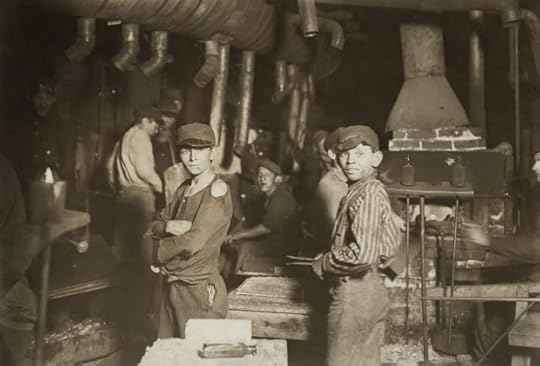
“Glassworks. Midnight. Location: Indiana.” From a series of photographs of child labor at glass and bottle factories in the United States by Lewis W. Hine, for the National Child Labor Committee, New York.
The first American Labor Day is dated to a parade organized by unions in New York City on September 5, 1882, as a celebration of “the strength and spirit of the American worker.” They wanted among, other things, an end to child labor.
In 1861, Lincoln told Congress:
Labor is prior to and independent of capital. Capital is only the fruit of labor, and could never have existed if labor had not first existed. Labor is the superior of capital, and deserves much the higher consideration. Capital has its rights, which are as worthy of protection as any other rights. Nor is it denied that there is, and probably always will be, a relation between labor and capital producing mutual benefits. The error is in assuming that the whole labor of community exists within that relation.
Today, in postindustrial America, Abraham Lincoln’s words ring empty. Labor is far from “superior to capital.” Working people and unions have borne the brunt of the great changes in the globalized economy.
But the facts are clear: In the current “gig economy,” the loss of union jobs and the recent failures of labor to organize workers is one key reason for the decline of America’s middle class.
This excellent essay by former Labor Secretary Robert Reich explores the vast inequities existing in America’s economy.
Read the full history of Labor Day in this essay: “The Blood and Sweat Behind Labor Day” (2011)
August 26, 2020
Don’t Know Much About® Lyndon B. Johnson
(Revise of 2013 essay)
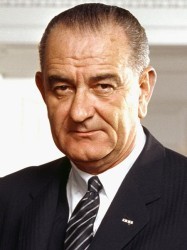
Lyndon B. Johnson (March 1964)
(Photo: Arnold Newman, White House Press Office)
All I have I would have given gladly not to be standing here today.
Lyndon B. Johnson, in his first address as President to a joint session of Congress (November 27, 1963)
The 36th President, Lyndon B. Johnson, was born on August 27, 1908, in a small farmhouse near Stonewall, Texas on the Pedernales River. Coincidentally, it is also the date on which LBJ accepted the 1964 Democratic nomination for President. (Senator Hubert H. Humphrey was his Vice Presidential nominee.)
In some respects, history and time have been kinder to Lyndon B. Johnson than his tortured Presidency –and certainly the critics of his day—would have possibly suggested. A power broker extraordinaire during his days in Congress, especially during his twelve years in the Senate, Lyndon B. Johnson challenged John F. Kennedy for the Democratic nomination in the 1960 primaries, and then accepted Kennedy’s offer to become his Vice Presidential running mate. Johnson was credited with helping Kennedy win Southern votes and ultimately the election.
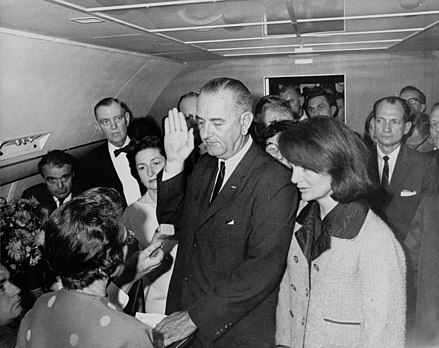
Lyndon B. Johnson taking the oath of office aboard Air Force One at Love Field Airport two hours and eight minutes after the assassination of John F. Kennedy, Dallas, Texas. Jackie Kennedy (right), still in her blood-soaked clothes, looks on. Public Domain-Source White House
On November 22, 1963, history and America changed with Kennedy’s assassination. Johnson became President, taking the oath of office aboard Air Force One with Jacqueline Kennedy, the dead President’s widow standing beside him.
Driven by a rousing sense of social justice, born out of his youth and upbringing in hardscrabble Texas and Depression-era experiences, he had become one of Franklin D. Roosevelt’s most loyal New Dealers. First in a federal job, then in Congress and later as “Master of the Senate.” As President, Johnson set the country on a quest for what he called the “Great Society,” looking for ways to end the great economic injustice and bitter racial disparity that existed in America in 1963. But his vision for a “Great Society” was counterbalanced, and ultimately overshadowed by his doomed course in pursuing the war in Vietnam.
In the midst of the war, recently released White House tapes reveal Johnson confided–
I can’t win and I can’t get out.
Fast Facts-
•Johnson was the first Congressman to enlist for duty after Pearl Harbor.
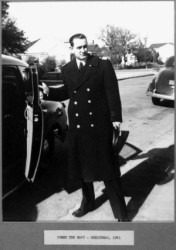
Lyndon B. Johnson as Navy Commander (Photo Credit: Lyndon B. Johnson Library and Museum)
•Johnson was the fourth president to come into office upon the death of a president by assassination. (The others were Andrew Johnson after Lincoln, Chester A. Arthur after Garfield, and Theodore Roosevelt after McKinley.)
•Johnson appointed the first black Supreme Curt Justice, Thurgood Marshall.
The Johnson Library and Museum is in Austin, Texas. Lyndon B. Johnson died at the age of 67 on January 22, 1973.
Resources on Johnson from the Library of Congress
Read more about Lyndon B. Johnson, his presidency and the Vietnam War and civil rights movement in Don’t Know Much About® the American Presidents and Don’t Know Much About® History.

Don’t Know Much About® the American Presidents

Don’t Know Much About History (Revised, Expanded and Updated Edition)
August 25, 2020
Who Said It? (1/23/2020)

Lyndon B. Johnson (March 1964)
(Photo: Arnold Newman, White House Press Office)
The collection of poll taxes in national elections was prohibited on January 23, 1964, with ratification of the Twenty-Fourth Amendment to the Constitution. Passage of the amendment affected voting in Alabama, Mississippi, Arkansas, Texas, and Virginia.
At ceremonies formalizing ratification in February, President Lyndon Johnson noted that by abolishing the poll tax the American people:
…reaffirmed the simple but unbreakable theme of this Republic. Nothing is so valuable as liberty, and nothing is so necessary to liberty as the freedom to vote without bans or barriers…There can be no one too poor to vote.
Source Library of Congress
The 36th President, Lyndon B. Johnson, was born on August 27, 1908, in a small farmhouse near Stonewall, Texas on the Pedernales River. Coincidentally, it is also the date on which LBJ accepted the 1964 Democratic nomination for President. (Senator Hubert H. Humphrey was his Vice Presidential nominee.)
August 16, 2020
The Top Ten Political Conventions That Mattered the Most
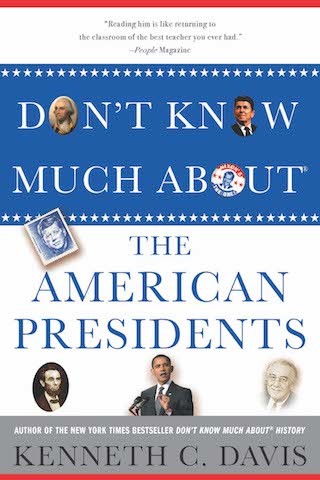
As the two parties shift their conventions to be mostly virtual, we look at those conventions that made a difference in the country’s political history…
1831 Anti-Masonic Convention—Why start with one of the most obscure third parties in American history? Because they invented nominating conventions. The Anti-Masons, who feared the growing political and financial power of the secret society of Freemasons, formed in upstate New York; among their members was future president Millard Fillmore.
The Top Ten Political Parties That Mattered the Most

As the two parties shift their conventions to be mostly virtual, we look at those conventions that made a difference in the country’s political history…
1831 Anti-Masonic Convention—Why start with one of the most obscure third parties in American history? Because they invented nominating conventions. The Anti-Masons, who feared the growing political and financial power of the secret society of Freemasons, formed in upstate New York; among their members was future president Millard Fillmore.



